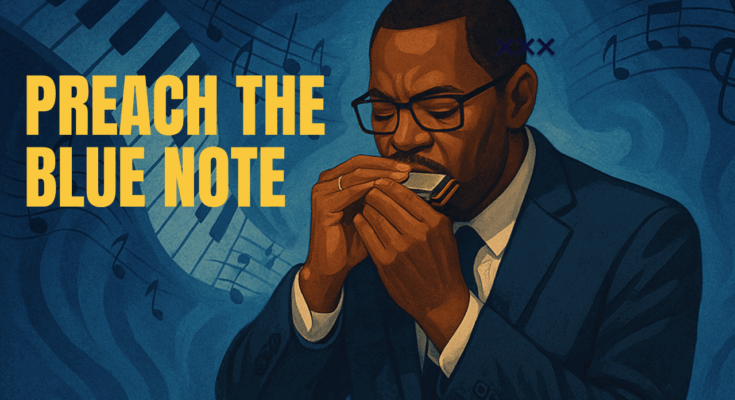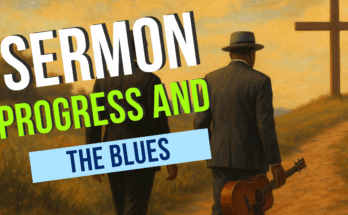As an Amazon Associate I earn from qualifying purchases.
You ever notice the real note isn’t always the one on the page?
In the blues, the right note is often in between the notes. Not the clean pitch the piano gives you, but the one living in the crack — the one you have to bend, slide into, and pull out of your own soul. And that’s where the truth is.
Preaching works the same way. To preach the blue note isn’t about being off-pitch — it’s about telling the truth in a way that’s truer than the scale.
The blue note: more than a pitch
On paper, the blue note is the flattened third, fifth, or seventh. In real life, it isn’t pinned to one exact spot. It bends. It slides. It shifts with the groove, the moment, the us of the band, and the I of the soloist.
A harmonica player pulls a note from somewhere between two pitches. A guitarist leans a string sharp until the lyric exhales. A singer shapes a vowel to fit the ache. A trumpeter tilts embouchure and air so the horn wavers outside its “proper” slot.
In real blues, the “right” note is often the one in between. That’s where the truth lives — and it changes from chorus to chorus, moment to moment.
The Us, the I, and the Call
We don’t play it the same way twice because the us is different — the band, the congregation, the room. The I is different — your headspace and heartspace today aren’t yesterday’s. And the call is different — the Spirit, the groove, the situation are pulling on you in new ways.
(See our piece where Wynton Marsalis breaks down these three: the Us, the I, and the Call.)
Learning the blue note
When I started on harmonica, I learned quick: the only thing you truly bring is feel — and feel demands the blue note.
If I’m not bending or sliding, I sound too clean, like I’m tracing the outline instead of living in the song. But when I bend… when I slide in from underneath or lean till it moans… now I’m speaking the song’s native tongue.
Preaching is the same. If you only play the clean scale — the safe, polished church phrases — you’re just outlining. When you preach from that in between space where pain, hope, and God’s truth collide, you bring something nobody else can.
When you just don’t feel like preaching
Let’s be real. Sometimes, I don’t feel like preaching. I’m tired. My spirit is low. The sermon still has to be preached. I can fake it — run the straight do-re-mi scale, toss an “Ain’t God good!” I don’t even feel — or I can bend the note and tell the truth.
That truth might sound like: “Y’all, I’m not feeling it today. Anybody ever been there? You had to sing, lead, teach, preach — but your soul was limping?” That’s the blue note in preaching — bending the clean line to fit the reality of your spirit.
- David: “Why are you cast down, O my soul?” (Psalm 42:5)
- Jeremiah: “Cursed be the day I was born!” (Jeremiah 20:14)
- Paul: “We were so utterly burdened beyond our strength that we despaired of life itself.” (2 Corinthians 1:8)
- Jesus: “My soul is overwhelmed with sorrow to the point of death.” (Mark 14:34)
None of them faked the scale. They found the in between and bent the note.
When music refuses the box
Classical theory locks every pitch in its slot. The blue note says, “I’m not here to fit your grid — I’m here to tell the truth.” It lives in the cracks between the keys — the place theory says there’s nothing, but history says there’s everything.
That sound rises from the African American experience — field hollers, spirituals, work songs that wouldn’t bow to European harmony. Think B.B. King holding a note till it hurts. Think Billie Holiday leaning behind the beat and reshaping a melody into her own truth.
The blue note in Scripture
Biblical faith knows the bend:
- “How long, O Lord? Will you forget me forever?” (Psalm 13:1)
- “I will speak in the bitterness of my soul.” (Job 10:1)
- “My God, my God, why have you forsaken me?” (Mark 15:34)
None of these are “off.” They’re truer than the clean scale because they live in the in between.
The beauty of the blue note
Here’s the irony: when resolution finally comes — today, tomorrow, or years from now — it’s richer because it came through the valley and wasn’t forced.
The glory of the blues is that the blue note is the beauty. Even the most triumphant songs keep those bent tones. Once you learn to speak through pain, you can speak to anybody — in pain or out — because somebody in your congregation needs to hear blessing through the blue note right now.
Stop trying to scrub the blues out of your preaching. Let the blues bring you there. Don’t hush Jesus when He says, “My God, my God, why have you forsaken me?” Remember how grand it is when He finishes that blues and declares, “Into thy hands I commit my spirit.”
What I mean by “preach the blue note”
- Allow the pain and hurt to come through. Don’t hide it. Don’t polish it away.
- Allow God to fix it in ways you’re not expecting. Let the resolution surprise you.
- Allow the truth to live in the cracks between the notes. The in between is where the real note is — and it may shift from one moment to the next.
Preach the blue note…preach the blue note
Amazon and the Amazon logo are trademarks of Amazon.com, Inc, or its affiliates.








